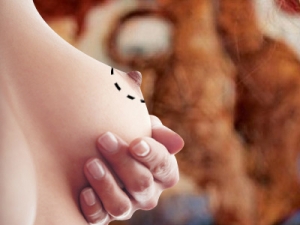An inverted nipple is a malformation, a distinctive feature of which is its immersion in the thickness of the chest, with the placement of the upper part at the level of the areola or lower.
Inverted nipples can have both women and men, and sometimes only one of them is inverted. In some people, the nipples are retracted from birth, in others, this condition develops later.
Generally speaking, this form of the nipple does not pose a health hazard and is not a cause for particular concern. Inverted nipples are not necessarily able to impede breastfeeding, as the baby can stick to the entire area of the areola (although, in general, it depends on the degree of retraction).
An inverted nipple comes in two basic forms:
- reversible nipple (retracted at rest, but easily extends manually or when cooled);
- irreversible inverted nipple (does not stretch even with stimulation).
Reasons for an inverted nipple
This anomaly is caused by too short milky ducts - galactophores that hold the nipple inside the chest. The problem affects an average of two women out of a hundred, and is usually inherited. In some cases, this is caused by an inflammatory process. Sometimes a type of temporary integrated nipple may occur after breastfeeding.
Inverted nipple and breast cancer
In some cases, an inverted nipple, especially if it is unilateral, or appeared suddenly, may be a symptom of breast cancer. Usually, the neoplasm is accompanied by other signs, such as: thickening of the tissue; breast asymmetry (the mammary gland becomes larger or smaller); the nipple changes its morphology «ripples»; appear around it; the skin around the nipple is reddened; purulent or blood secretions are observed, pain in the chest or under the armpits, swelling in the armpit or around the clavicle.
If you notice that one or both of the nipples began to retract for a short period of time - this is a serious reason to visit mammologist of MC Bogoliuby. Diseases that provoke the condition do not have to be associated with malignant degeneration of the gland. It can also be: mastitis, ectasia of the milk duct or areola abscess.
Treatment of an inverted nipple
If the patient is concerned about this malformation for aesthetic reasons, or there are problems with breastfeeding, then it makes sense to consult a doctor. There are several helper methods.
Firstly, this is the Hoffman technique, which consists in manually stretching the nipple with certain movements.
Secondly, these are suction devices - a non-invasive way to extract the nipple. They are used with a slight degree of retraction. There are special devices that create outside the vacuum with negative pressure, pushing the nipple out. Usually they are applied for 6 hours a day, for at least three months. Their minus is that devices can cause ulceration of the nipple if the skin is very thin.
Thirdly– this is plastic surgery, which, of course, is the most effective. It consists in making a small section of the nipple, through which fibrous structures and galactophores too short are removed. At the end of the operation, the nipple is sutured both internally and externally.
The operation lasts about an hour, and is usually performed under local anesthesia. A surgical dressing should be worn 5 to 7 days. Sutures, if not absorbed, are removed after 10 days. Initially, the area of intervention may be swollen, but the swelling will gradually decrease until it disappears after about two weeks.
It should be noted that in the postoperative period, the sensitivity of the areola and nipple can be changed, but this is a temporary phenomenon. Everything will return to normal within about a few weeks or months. Specialists of Bogoliuby MC use modern surgical techniques for plasty of the retracted nipple. Our doctors strive to maintain normal sensitivity in the nipple, while maintaining the normal functioning of the milk ducts, if possible.
If the inverted nipple is caused by a malignant tumor, then therapy corresponding to the type of pathology is prescribed for treatment.

















